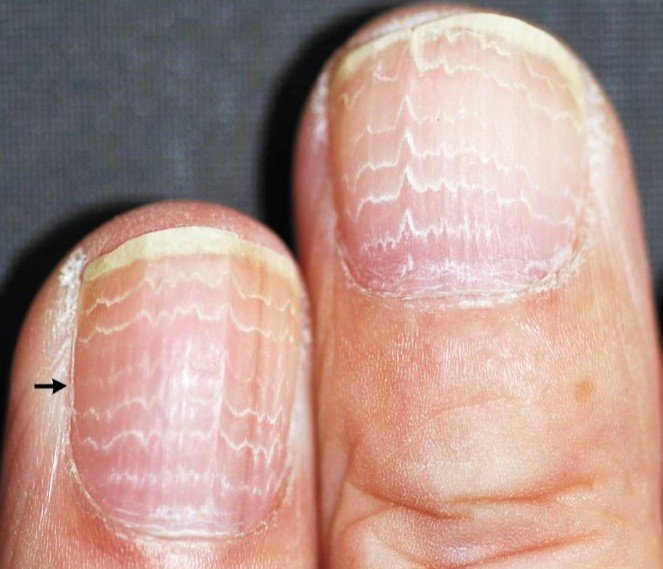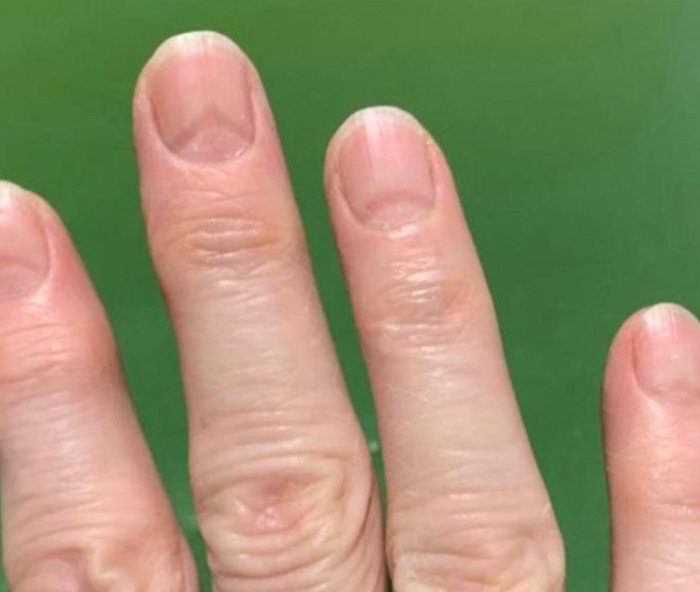Can COVID-19 Impact Nails?
This article provides information on the 5 most common skin and nail issues associated with long COVID. These are indicators of the histamine cascade, inflammation, hypoxia (low oxygen), micro clotting, and vascular (blood vessel) constriction caused by the cytokine storm (immune system disruption). This article contains graphic images.
Updated January 7, 2025
COVID nails are skin and nail issues can happen a few days, weeks or months after a COVID-19 infection. They can indicate that the infection stressed your body, or they could be a rare symptom of the infection itself, depending on your symptoms. Some of these conditions, such as the vesicular eruption, appear early in the disease course; others are seen later, such as the chilblain pattern. Researchers suspect that inflammation, low oxygen, and histamine reactions contribute to many of these conditions. Be forewarned - There are medical pictures of each condition that are too graphic for children and some readers.
Tips for managing rashes and blisters
The biggest concern with open wounds is infection. It is a good idea to wash wounds 1-2 times daily with a gentle soap and warm water. Another option is a soak in warm water with Epsom salts to speed up healing.
A steroid or antihistamine cream (like Benadryl or diphenhydramine) can be used on rashes and papular eruptions as long as the blisters have not broken open. Follow package instructions and check with your doctor or pharmacist before using new medicines.
Don’t use a steroid, antihistamine, or other topical (skin) creams on open wounds unless your doctor tells you to because the exposure to the blood stream changes the absorption and carries a risk of infection.
5 patterns of Long COVID cutaneous (skin, hair, nails) issues
Maculopapular eruption
May present as flat and raised skin lesions. The name is a blend of the words “macule,” which are flat discolored skin lesions, and “papule,” which are small, raised bumps. These skin lesions are usually red and can merge together. Macules that are bigger than 1 centimeter are considered patches, while papules that are merged together are considered plaques. A maculopapular rash is a marker for many diseases, allergic reactions, and infections. Most of the time, the cause is a viral infection. See a doctor if you have a maculopapular rash. The rash could indicate a serious disease.
Chilblain lesions
Chilblains (CHILL-blayns) is a condition that causes inflamed swollen patches and blistering on the hands and feet. It's often associated by exposure to damp air that's cold but not freezing, but COVID-19 related chilblain is a result of inflamed blood vessels and hypercoagulability (blood clotting). The condition doesn't usually result in permanent injury to the nailbeds, but it is a warning sign for blood clotting and stroke. Symptoms of chilblains include Small, itchy areas on your skin, often on your feet or hands; sores or blistering; swelling; pain or stinging; changes in skin color.
Urticarial lesions
Urticarial lesions, also known as hives, are reddish or skin-colored flat patches of swelling with a smooth surface that lasts more than 24 hours. Skin lesions typically resolve in 1-14 days with antihistamines and/or steroids. Management of urticarial lesions in Long COVID most often involves antihistamines. Low dose prednisolone may be considered on an individual basis.
Vesicular eruption
A vesicle is a small, fluid-filled blister. It can range in size from tiny to the size of a pencil eraser. A vesicular rash occurs when there are vesicles in the area of your rash. Most vesicular rashes are harmless and will go away, but there are some serious diseases that can cause vesicular rashes. Many report having rashes or shingles periodically with Long COVID, but do not respond to shingles medications. These rashes are not well understood, but some can be traced back to MCAS related histamine release triggered by physical or emotional stress, food, medications, or heat.
Beau’s lines
Beau’s lines are a sign that your body was struggling with COVID or another stressor, interrupting the way the nails grow. They look like dents or ridges across your nails. They can be caused by a nail injury, like slamming your finger in a door, but they may also occur after you’ve been sick or really stressed. They are grooves in the nail plate that result from interruption of nail growth. They are often noticed 2–3 weeks after a systemic accident, illness or trauma.
Beau’s lines after COVID-19 because the body had to preserve vital organ function. Nails are not vital to survival, so they rank much lower on the priority list when you’re extremely sick. They don’t show immediately because it takes several weeks for the damaged part of your nail to emerge from the nail bed that is under your skin. By the time you see them, you may not even realize what caused them.
Red half-moon shape on nails
A red half-moon shape on the nails after a COVID-19 infection may develop during or shortly after infection. The redness outlines the white part of the nail. Doctors regard this as a COVID specific symptom and may consider it as a diagnosis confirmation.
The cause is unknown, but likely signifies vascular inflammation of the blood vessels or vessel damage. It may also indicate a risk of micro-clotting, a common post COVID issue that happens when the platelets in your blook become more sticky than usual.
Treatment may include antihistamines to reduce the MCAS histamine cascade, anti-inflammatories to reduce vessel inflammation and anticoagulants to reduce the risk of clotting.
Livedo reticularis
Livedo reticularis, commonly known as mottled skin, causes patterned areas to appear on the skin. It may result from reduced blood flow to the skin, for example, because of a health condition or cold weather. When a person has livedo reticularis a blotchy or web-like pattern of red, blue, or purple lines appears across the skin. In very deep skin tones, the pattern may be a dark brown. Livedo reticularis may result from reduced blood flow to an area of the skin. Long COVID can cause vascular inflammation, reducing blood flow to an area of the skin, and it can cause micro clots by making the platelets stickier than normal, blocking blood flow.
When to call the doctor
If you notice any of these skin symptoms, check in with your doctor. Keep in mind that issues described about the nails don’t present a current health threat but do indicate your body went through a difficult challenge in the last weeks or months.
Things you can do to help yourself
Minimizing physical & psychological stressors is essential in recovery from Long COVID.
Nutrition: Try to eat protein and fresh vitamin rich foods daily and avoid chemicals, preservatives, sugars, fast foods, prepared foods and high histamine foods.
Don’t skip meals. Your body needs protein, vitamin C, and vitamin D to heal from any injury or illness. A low histamine or low carbohydrate (sugar) diet is recommended by doctors treating Long COVID (PASC), and many people report a reduction in symptoms within 1-3 days of the diet change, including decreases in sneezing, itching or hives, irritable bowel syndrome, body pain, along with a reduction in swelling and inflammation.Hydration: A minimum of eight 8 oz glasses of plain water daily is recommended.
Avoid drinks with chemical additives. You can easily make a fresh electrolyte drink yourself by adding a dash of mineral rich Epsom salt and a piece a fruit like a raspberry for flavor instead of spending money on commercial drinks like Gatorade that contain chemicals and sit in plastic bottles for long periods of time. Remember that caffeine and alcohol have dehydrating effects.Sleep hygiene: Getting 7-9 hours of sleep so your body can repair itself. You need at least 4 hours of uninterrupted sleep to get into the restorative phase of sleep.
Avoid stimulating activities after dinner like thrilling movies or books, arguments, negative news or frustrating stimuli.
If you wake up frequently or with a startle, you may be experiencing drops in your oxygen level, which signal your brain to release adrenaline to force you to take a breath. This could be a temporary inflammation issue or more enduring sleep apnea. Ask your doctor for a sleep study to evaluate your need for a CPAP or BiPAP, a machine that pushes air into your lungs when it senses an apneic episode (periods of not breathing).Stress management: Stress effects every component of your life.
The only thing you can control about stress is your reaction to it. Try to avoid or minimize your exposure to stressful situations: Turn off the news, make family visits that end unpleasantly short, wait for the morning to have intense discussions, let go of things that annoy you but don’t really matter in the big scheme of things, avoid intense conversations or entertainment in the evening.
Exercise within tolerance: Pace yourself and do not push your body to extremes in any way.
For some this may mean seated breathing exercises, walking to the mailbox. Rest when your body says to slow down. Gradually build on your activity endurance as your body cues you to progress. This can be hard to gauge, because when you feel good you naturally do more, but if you do too much you may experience symptom flare ups 1-3 days later as the post exertion inflammation builds. Some people describe this as post exertional malaise, others experience severe recovery set backs.
Breathwork: You can literally stop the fight or flight reaction by taking slow deep breaths.
Deep slow breathing shuts down the adrenaline flow, slows your heart rate, lowers your blood pressure and decreases stress related histamine release. When you do this, your blood reroutes back to your brain and nervous system to allow you to think clearly. It also allows your body to use its energy and oxygen to heal your inflamed nerves and organs.
ProMedView Nurse Coaches - We get it.
Our clinical experts advocate for those with Long COVID.
Individual coaching
Group Q&A sessions
Peer support groups
Keep moving, keep breathing.
Brought to you by covidCAREgroup, connecting the dots of long COVID through education, research and resources.
COVID Care Group, LLC is not a healthcare provider and does not provide medical advice, diagnosis, or treatment.
Article resources
Beau lines associated with COVID-19 by Saud Alobaida, MD and Joseph M. Lam, MD
Beau lines associated with COVID-19 | CMAJ
Beau lines associated with COVID-19 - PubMed (nih.gov)
Maculopapular Rash: Causes, Treatment, and More (healthline.com)
Chilblains - Symptoms and causes - Mayo Clinic
Management of urticaria in COVID-19 patients: A systematic review - PubMed (nih.gov)
Vesicular Rash: What It Is, How It’s Treated, and More (webmd.com)
Mottled skin (livedo reticularis): Causes, treatment, and more (medicalnewstoday.com)
Original publication date: July 8, 2021







































